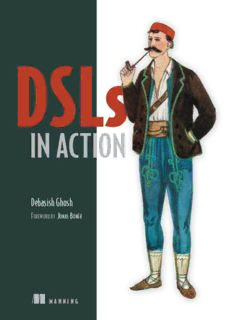Table Of ContentIN ACTION
Debasish Ghosh
FOREWORD BY JONAS BONÉR
M A N N I N G
DSLs in Action
DSLs in ACTION
DEBASISH GHOSH
MANNING
Greenwich
(74° w. long.)
For online information and ordering of this and other Manning books, please visit
www.manning.com. The publisher offers discounts on this book when ordered in quantity.
For more information, please contact
Special Sales Department
Manning Publications Co.
180 Broad St.
Suite 1323
Stamford, CT 06901
Email: [email protected]
©2011 by Manning Publications Co. All rights reserved.
No part of this publication may be reproduced, stored in a retrieval system, or transmitted, in
any form or by means electronic, mechanical, photocopying, or otherwise, without prior written
permission of the publisher.
Icons in the book are from www.picol.org, used under license as described at
http://creativecommons.org/licenses/by-sa/3.0/
Many of the designations used by manufacturers and sellers to distinguish their products are
claimed as trademarks. Where those designations appear in the book, and Manning
Publications was aware of a trademark claim, the designations have been printed in initial caps
or all caps.
Recognizing the importance of preserving what has been written, it is Manning’s policy to have
the books we publish printed on acid-free paper, and we exert our best efforts to that end.
Recognizing also our responsibility to conserve the resources of our planet, Manning books
are printed on paper that is at least 15 percent recycled and processed without the use of
elemental chlorine.
Manning Publications Co. Development Editor: Cynthia Kane
180 Broad St. Copyeditor: Joan Celmer
Suite 1323 Typesetters: Dennis Dalinnik
Stamford, CT 06901 Cover designer: Marija Tudor
ISBN 9781935182450
Printed in the United States of America
1 2 3 4 5 6 7 8 9 10 – MAL – 16 15 14 13 12 11 10
To my grandfather, who taught me my first alphabet
brief contents
PART 1 INTRODUCING DOMAIN-SPECIFIC LANGUAGES . ...............1
1 ■ Learning to speak the language of the domain 3
2 ■ The DSL in the wild 25
3 ■ DSL-driven application development 54
PART 2 IMPLEMENTING DSLS ..................................................85
4 ■ Internal DSL implementation patterns 87
5 ■ Internal DSL design in Ruby, Groovy, and Clojure 128
6 ■ Internal DSL design in Scala 166
7 ■ External DSL implementation artifacts 211
8 ■ Designing external DSLs using Scala parser
combinators 241
PART 3 FUTURE TRENDS IN DSL DEVELOPMENT.....................275
9 ■ DSL design: looking forward 277
vvii
contents
foreword xiii
preface xv
acknowledgments xvii
about the book xix
PART I INTRODUCING DOMAIN-SPECIFIC LANGUAGES .....1
1 Learning to speak the language of the domain 3
1.1 The problem domain and the solution domain 4
The problem domain 4 ■ The solution domain 4
1.2 Domain modeling: establishing a common vocabulary 6
Benefits of a common vocabulary 7
1.3 Introducing DSLs 8
What’s a DSL? 10 ■ Popular DSLs in use 12
Structure of a DSL 14
1.4 Execution model of a DSL 15
1.5 Classifying DSLs 17
Internal DSLs 18 ■ External DSLs 18
Nontextual DSLs 19
vii
viii CONTENTS
1.6 When do you need a DSL? 20
The advantages 20 ■ The disadvantages 21
1.7 DSLs and abstraction design 22
1.8 Summary 23
1.9 References 24
2 The DSL in the wild 25
2.1 Building your first Java DSL 26
Setting up the common vocabulary 27 ■ Your first
Java implementation 28
2.2 Making friendlier DSLs 32
Externalizing the domain with XML 32 ■ Groovy:
a more expressive implementation language 33
Executing the Groovy DSL 35
2.3 DSL implementation patterns 36
Internal DSL patterns: commonality and variability 37
External DSL patterns: commonality and variability 45
2.4 Choosing DSL implementations 50
2.5 Summary 52
2.6 References 53
3 DSL-driven application development 54
3.1 Exploring DSL integration 55
Why you should care about DSL integration 56
3.2 Internal DSL integration patterns 58
Using the Java 6 scripting engine 60 ■ Using a DSL
wrapper 64 ■ Language-specific integration
features 73 ■ Spring-based integration 75
3.3 External DSL integration patterns 76
3.4 Handling errors and exceptions 78
Naming an exception 79 ■ Handling incorrect typing errors 80
Handling exceptional business conditions 81
3.5 Managing performance 82
3.6 Summary 83
3.7 References 84
CONTENTS ix
PART II IMPLEMENTING DSLS ......................................85
4 Internal DSL implementation patterns 87
4.1 Filling your DSL toolbox 88
4.2 Embedded DSLs: patterns in metaprogramming 90
Implicit context and Smart APIs 91 ■ Reflective
metaprogramming with dynamic decorators 96
Reflective metaprogramming with builders 102
Lessons learned: metaprogramming patterns 105
4.3 Embedded DSLs: patterns with typed abstractions 106
Higher-order functions as generic abstractions 106
Using explicit type constraints to model domain logic 113
Lessons learned: thinking in types 117
4.4 Generative DSLs: boilerplates for runtime
generation 118
How generative DSLs work 118 ■ Ruby metaprogramming
for concise DSL design 119
4.5 Generative DSLs: macros for compile-time code
generation 122
Metaprogramming with Clojure 122 ■ Implementing the
domain model 123 ■ The beauty of Clojure macros 125
4.6 Summary 126
4.7 References 127
5 Internal DSL design in Ruby, Groovy, and Clojure 128
5.1 Making DSLs concise with dynamic typing 129
Readability 130 ■ Duck typing 131 ■ Metaprogramming—
again! 133 ■ Why Ruby, Groovy, and Clojure? 134
5.2 A trade-processing DSL in Ruby 135
Getting started with an API 136 ■ A little bit of
monkey-patching 139 ■ Rolling out a DSL interpreter 140
Adding domain rules as decorators 143
5.3 The order-processing DSL: the final frontier in
Groovy 148
The order-processing DSL so far 148 ■ Controlling the scope of
metaprogramming 149 ■ Rounding it off 152
Description:Your success—and sanity—are closer at hand when you work at a higher level of abstraction, allowing your attention to be on the business problem rather than the details of the programming platform. Domain Specific Languages -- “little languages” implemented on top of conventional programming

